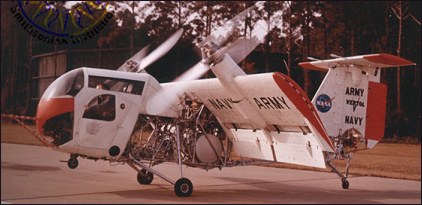Vertol, with its long helicopter history, began involvement with Tilt-Wing investigations in the 1950s with work on its company-designated Model 76 program. The research would be affirmed with a joint Army/Navy contract, signed on April 15, 1956, with the effort being defined as the VZ-2A program. With the cost of modern day military contracts, the design and development was for the momentous amount of $850,000 !
The resulting vehicle could best be described as "frail looking", with much of the fuselage being of open-tubular construction. If you were to view the vehicle strictly from the front, you would swear that this was a helicopter-type vehicle with its characteristic bubble-type cockpit. That cockpit was located far forward of the wing pivot point and featured side-by-side seating for the two-man crew.
For safety considerations, there were also dual controls which could move control surfaces on the tall-straight-up vertical stabilizer topped with a flat horizontal "T" configuration. The complexity of the concept was increased with the addition of a pair of ducted fans for pitch and yaw control, both being located in the tail configuration.
Appearing as a last-second add-on, the vehicle's 660 horsepower Lycoming YT53-L-1 turboshaft was mounted by struts above the fuselage. The exhaust was vented outward to the left side of the rear stabilizer. Since the propellers were not attached to actual engines, the units that transferred the power from the fuselage-mounted engine resulted in considerably smaller wing units than the actual engine installations in other Tilt Wing concepts.
A portion of the turbine power was also transmitted through shafting to two ducted fans, one in the vertical and the other in the horizontal stabilizer. These fans, through a pitch-changing mechanism, were used for pitch and yaw control of the craft during hovering and transition flight.
Then, through a complex system which incorporated a cross shaft arrangement, the power was transferred to the pair of wing-mounted rotors which were located close to the center point of each wing. The rotors were extremely large in diameter, at nine and one-half feet in span, and each carried three blades. The variable-pitch rotors, in addition to their primary power requirement, also provided supplemental roll control.
The craft proved to be extremely maneuverable, but was extremely slow with a maximum speed of only 215km/h. For safety purposes, the propellers were interconnected.
Like other Tilt-Wing concepts, the VZ-2A, with a gross weight of only 1220kg, employed a pair of modes of operation during the lift-off to the normal flight phase. As the craft moved away from the hover phase, the normal aerodynamic forces on the plane's wing and tail control surfaces came into play. Also for aerodynamic reasons, the rear fuselage of the plane would later be skinned for smoother air flow.
Dimensionally, the VZ-2A was a small craft with a wing-span of only 7.6m and a fuselage body length of 8.2m. The maximum height was 4.6m.
The VZ-2A was first flown in the late 1950s, however, before that time the configuration had been tested by NASA at its Langley Research Center wind tunnel. The research had shown possible stall problems might be encountered during the transition phase on the initial VZ-2A configuration, which at the time had no wing flaps.
The first VZ-2 vertical flight took place in April 1957. On July 15, 1958, the first complete transition took place, demonstrating vertical take-off to cruise flight and then back to a vertical landing.
That four-decades-ago flight made VTOL history and proved that the Tilt-Wing concept was viable and certainly surprised many doubters that the technique could work. It was an extremely short flight, and as described by the press as follows:
"The pilot lifted this aircraft as a helicopter, tilted the wings for a short horizontal flight, then converted back to hover and a vertical landing."
The model also served as a great teaching tool, as many pilots were checked out in the unique bird. Once the military was completed with the VZ-2, the plane was turned over to NASA, where it continued to fly until 1965. In all, there were only 450 flights made by this unique craft, including 34 full conversions.
In recognition for its many accomplishments, upon its retirement, the VZ-2A was given a place of honor at the rare bird alcove of the Smithsonian Institution.
S.Markman & B.Holder "Straight Up: A History of Vertical Flight", 2000
During the mid-1950s the Army became particularly interested in the possible military applications of V/STOL aircraft, and consequently contracted with several aircraft manufacturers for the development of such vehicles. Among the many innovative designs to appear during this V/STOL era was Vertol's Model 76, the first aircraft in the world to make use of the tilt-wing concept. The single example produced (serial 56-6943) was funded jointly by the Army and the Office of Naval Research (ONR), and made its first hovering flight in the summer of 1957.





